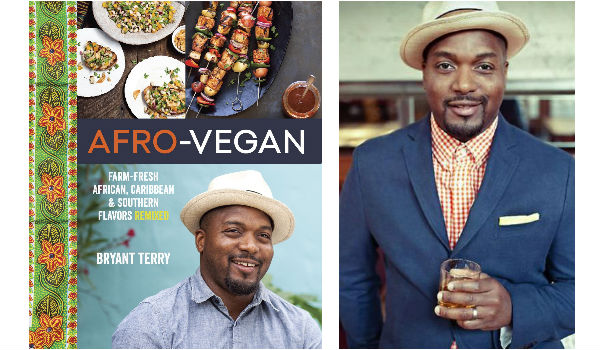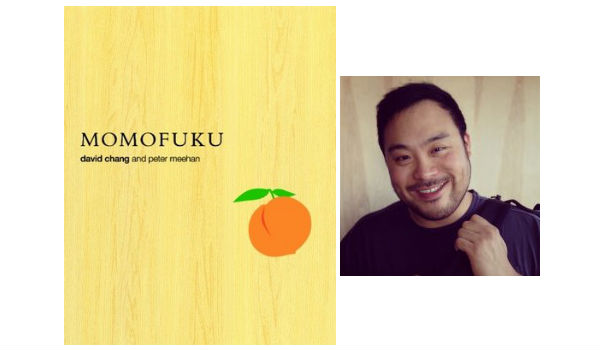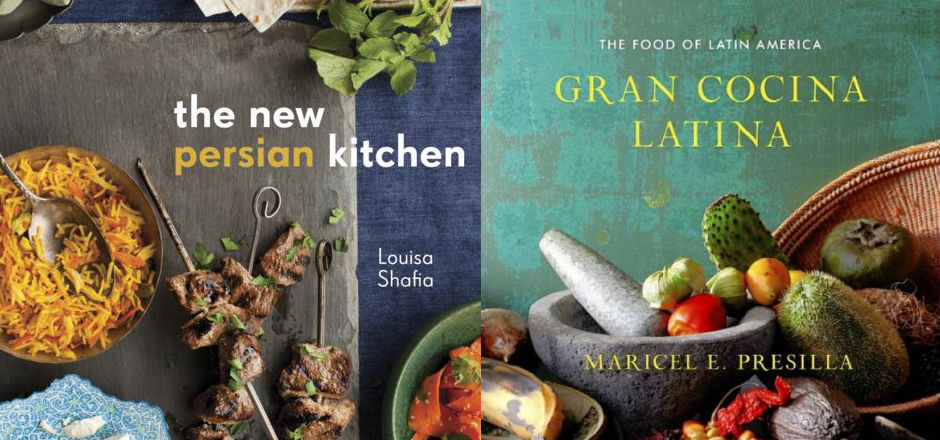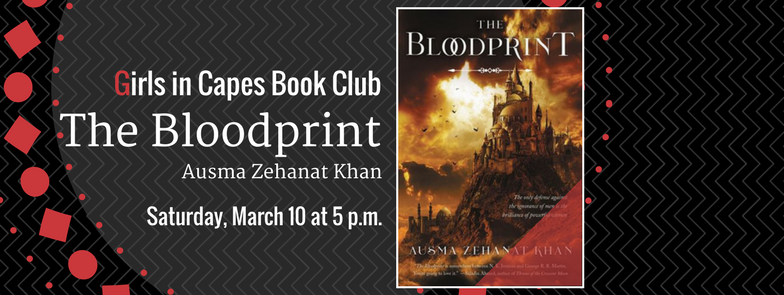[dropcaps]J[/dropcaps]uly is The Multiracial Issue, and in wake of the #WeNeedDiverseBooks events and discussion, Girls in Capes invites guests to share five diverse books in different genres with our readers. Today, Susan and Alyssa of Read This/Eat That share five cookbooks to add to your kitchen.
If you were to ask us if our kitchens reflected the diversity we see around us, we would say yes, absolutely. A quick glance at the ingredients we keep on hand would probably convince you that we’re not kidding. Miso? Za’atar? Peanut oil? At least five types of flour? Of course! But when Girls in Capes asked us to think of our favorite American cookbook writers who demonstrate diversity, we had to awkwardly admit that as diverse as our spice shelves may be, our bookshelves could use some work. In fact, based on Amazon.com’s bestselling cookbook list, a lot of Americans seem to have the same problem we have. Paleo diets and anti-wheat sentiment seem to be a priority—racially and ethnically diverse cookbooks and authors, less so.
We enjoy cookbooks focused on different ethnic cuisines, and think they are invaluable to the cooking landscape—they serve as an entry point for people of different cultural backgrounds to discover, enjoy, and celebrate a diversity of dishes that they might not otherwise have access to. But the way we see it, diversity in modern American cooking goes beyond traditional ethnic cooking. When we congratulate ourselves for finding diversity in people of color writing ethnic cookbooks based on their heritage, there is a risk that we may be praising ourselves for recognizing the “otherness” of those writers rather than simply their good taste in food and skill in conveying it to us. With this in mind, we sought to take the next step in curating our list.
In a land rich with people of different cultures, we see Americans of all backgrounds eagerly exploring other cuisines and adapting their tastes and cooking as a result of their exploration. So when we set out to look for diversity in our cookbooks, we looked for American writers whose childhood kitchens may have had different smells than our own, but whose culinary creativity makes pigeon-holing them into one specific cuisine impossible.
We are excited to share the following five cookbook writers with you, as we see them as truly modern American cooks, acting in conversation with food trends of today, or in some cases starting their own. We hope you will be inspired to seek out some of these authors and cookbooks, and to see what else the modern culinary landscape has to offer! Bon appétit!

Louisa Shafia: The New Persian Kitchen (2013), Lucid Food (2009)
Louisa Shafia grew up eating a fusion cuisine that reflected the fusion of her own family’s mixed cultures. Her mother, a gourmet home cook of the Julia Child and James Beard schools, had family recipes from the Ashkenazi Jewish tradition, and merged these influences into her Iranian Muslim husband’s favorite Persian foods. Coming from that rich and creative background of food, Louisa Shafia presents fresh takes on Persian cooking in The New Persian Kitchen, and discusses sustainable agriculture and seasonal eating inspired by many cuisines in Lucid Food, her first cookbook.
Shafia, like many modern cooks we admire, is very much about the sensuousness of food, and the place of food in our lives. Lucid Food is a call for conscious food practices, hailing the growth of Community Sponsored Agriculture in recent years, and offering pages of advice such as how to recycle and compost at home, which seafood is sustainably sourced, and considerations when choosing to eat meat. The book focuses on eating in an environmentally friendly and healthy way, its recipes chosen for how they speak to seasonal abundance and moods. The flavors tend to be mild: a dash of soy sauce, a drizzle of oil, a squeeze of citrus, etc., but the combinations of vegetables, fruits, and grains make bold statements. Shafia comes from a minority cuisine in the United States but her approach to food and cooking is the same as many natural foods cooks and bloggers. She uses produce outside of general attention (lamb’s quarters, dumpling squash, quince, oh my!) in recipes that are simple enough to make up for the slight complication of trying to think where to forage or find the ingredients.
We are as excited to feature Shafia for her advocacy for sustainable agriculture and eating natural whole foods, as we are for her second cookbook, a more personal exploration of her Persian family’s cooking traditions. Having established herself as a natural foods cook in Lucid Food, she returns to the flavors and methods of her family kitchen, and shows Persian cuisine in line with the principles she explained in Lucid Food. Instead of limiting marketing of The New Persian Kitchen to the farmers’ market community as would be logical after the success of Lucid Food, Shafia is taking her natural foods message to synagogues and Jewish Community Centers through her discussion of what food means in expatriate Jewish Iranian identity. She puts it clearly: “I think that food can be a way to embrace differences and find commonality, because it’s something that brings everyone so much joy.” Shafia, in particular, seems to have found a way simultaneously to look at food with an eye for how American food politics will affect the future, as well as with a glance back towards the Persian food of her youth.

Kim Sunée: A Mouthful of Stars (2014), Trail of Crumbs (2008)
Kim Sunée’s first book, Trail of Crumbs, is a memoir of food, travel, and the search for identity. Her latest book, out this past May, is her first cookbook. Its title, A Mouthful of Stars, is beautifully evocative, and perfectly represents the equally beautiful, poetic, and moving writing and images contained in the book itself. To say her life has been interesting would be an understatement—born in Korea and abandoned at a market as a toddler, she was adopted by a New Orleans couple and grew up in the South. As an adult, she has traveled the world and lived in diverse locales, including a decade spent in France, eating and writing her way through markets, restaurants, and kitchens, experiencing what each place has to offer. The search for home is a strong theme in her work, and her writing on the subject is elegant and affecting.
In A Mouthful of Stars, she brings attention to the deep connection between food and memory for herself and all of us, and she arranges her book accordingly. Rather than the usual divisions of meats, vegetables, baked goods, etc., she has chapters filled with recipes and reminiscences of things eaten and loved from the different phases of her life—foods discovered on visits to Seoul that have nourished her sense of a lost home, favorite spicy dishes from her travels, recipes from her time in Provence, the New Orleans and Southern foods of her childhood in Louisiana, and many others. She also includes a selection of recipes for “an orphan’s Thanksgiving,” a few poems, and inspiring, whimsical menu suggestions for such themes as “tête à tête” and “starry, starry night: picnic under the stars.”
We think Kim Sunée and her work embody the idea of diversity because she has picked up bits and pieces of every place she has traveled and made them a part of who she is. Herself an individual with a unique heritage, she celebrates and honors the diverse cuisines, places, and people she has encountered over the course of her life so far. As Frances Mayes puts it in her introduction, “Kim’s allegiance is to a global kitchen. Her friends who cook are scattered across the map. A citizen of the world, she’s not tied to a particular terrain. This is the future. She’s already where we’re headed. And the food—paradiso!”

Bryant Terry: Afro-Vegan (2014), The Inspired Vegan (2012), Vegan Soul Kitchen (2009), Grub (with Anna Lappé, 2006)
Bryant Terry rose to culinary fame by drawing attention to what seems like an oxymoron of a cuisine: vegan soul food. Read a few pages of any of his published work, however, and you’ll find that traditional African American cooking involves many vegetables and fruits, making the difference between Terry’s version and the mainstream soul food of his childhood slight. As Terry points out, the only reason we might think it’s such an unusual way to cook is that the popular stereotype of the cuisine is of its deep-fried and sugary foods that traditionally would be rarely eaten. Terry also suggests that the stereotype of soul food leads many to dismiss the regional cuisine, pushing the food culture of African Americans away from our “collective culinary consciousness.” Herein lies another reason Terry’s fame is only continuing to rise: Terry is one of the most appealing advocates for food reform, from better environmental practices on the farming side to fresher cooking practices in the home, as well as more honest narratives about the role of African and African American food, taste, and cooking styles in healthy diets.
But the main reason you’re going to see and hear Bryant Terry’s name frequently in the future? His recipes are delicious! They’ve been published in everything from The New York Times to Yoga Journal, as well as on blogs of all sizes. Cooking shows invite him to make food on air. And his new cookbook, Afro-Vegan, just published in April, is a work of art. Published by Ten Speed Press, Afro-Vegan has gorgeous full-page photos of completed dishes like perfectly grilled tofu and summer vegetable kebabs, as well as photos of the freshest-looking ingredients imaginable, like heirloom tomatoes and half-husked corn. Pictures of Terry and his family pop up too, visually reinforcing that these are recipes for a home-cooked meal with family. For every recipe Terry offers a soundtrack. The result is that by the time you start pulling ingredients out of your cupboards, you’re already having a party in your kitchen, or you’re in a dreamy mood. Terry makes food into an omni-sensual and thinking experience. And the food! Terry’s aim in writing the book is to make a collage of foods from Africa and the African Diaspora, cutting out the animal products and adding his own touches. It’s quite difficult to miss meat with the array of natural whole foods recipes in this book. Texas Caviar on Grilled Rustic Bread (a colorful salad of black-eyed peas and fresh vegetables) looks set to replace the tired bruschetta of party appetizer plates. More than that, the cookbook looks set to replace, once and for all, the notion that vegan organic cooking exists separately from African Diaspora food, and to celebrate the diversity of foods African Diaspora cuisine has brought to America.

David Chang: Lucky Peach (started in 2011), Momofuku (with Peter Meehan, 2010)
If you’re into food culture, David Chang is pretty ubiquitous these days. This Korean-American chef, known for his creative elevation of ingredients and for having a bit of a bad-boy attitude, has quite the CV. His Momofuku restaurants, which started with Momofuku Noodle Bar in New York, now have multiple locations with different specialities, and he’s moved beyond New York to open locations in Australia and Canada. He’s been nominated for and won multiple James Beard awards (which are kind of like the Oscars of the foodie world), and he was one of Time’s 100 Most Influential People in 2010. As if all that wasn’t enough, his name is on multiple cookbooks and he founded Lucky Peach, a quarterly food-focused magazine published by McSweeney’s. He has been on HBO’s Treme. Heck, he’s even appeared in Audi commercials recently! This guy has swiftly become one of the most recognizable faces of modern cuisine, and has achieved incredible success and renown at a young age.
But for now, let’s focus on his first cookbook, simply titled Momofuku. It covers the birth and growth of the restaurant, and some of Chang’s experiences on the path to successful chefdom. Of course, it also includes recipes galore, from comestibles as simple as pickles on up to things as potentially fear-inducing as fried pig’s head medallions. There are recipes that result from his obsession with ramen, ones that take inspiration from his Korean heritage, and others that reflect flavors picked up during his time living in Japan. As the book goes on, the recipes become more and more fusion-y: bacon dashi broth with potatoes and clams, steak served with kimchi puree, ham terrine, shortcakes… From the astonishingly simple to the more complex and adventurous, Chang’s efforts in the kitchen reflect an idea of American food seen through a lens of multiculturalism and iconoclasm. His writing collaborator, Peter Meehan, describes it well in his introduction:
“Momofuku, the name, is Japanese; David Chang, the owner and head chef, is Korean American; the food eludes easy, or really any, classification. There is a focus on good technique, on seasonality and sustainability, on intelligent and informed creativity…he’s made the argument that Momofuku tries to serve delicious ‘American’ food. Seems like the most useful descriptor to me. Where else would labne and ssämjang and Sichuan peppercorns and poached rhubarb all end up in the same kitchen?”
Chang gathers eclectic ingredients and influences, and merges them to create food that is uniquely him. This is a man who is not afraid to do what he wants, culinarily and otherwise, and he never apologizes for it.

Maricel E. Presilla: Gran Cocina Latina (2012), The New Taste of Chocolate (with Penny de los Santos, 2009)
Maricel Presilla is yet another multiple James Beard award nominee and winner, and is the chef/co-owner of two restaurants in New Jersey, as well as of other Latin American food-oriented shops. She has written multiple cookbooks, but Gran Cocina Latina is her magnum opus of Latin American cuisine. Ingredients, tools, techniques, recipes…it’s all included. And when we say magnum opus, we really do mean magnum opus—this sucker clocks in at around 900 pages, so be careful not to drop it on your toes! Born and raised in Cuba but transplanted to the United States, Presilla states that she gave up one citizenship but gained two—that of an American, and also of a Latin American. She discusses how joining this community of Spanish-speaking Latin Americans living in the U.S. became a process of discovery that has been a strong influence on her cooking. Further influences on her include the university medieval studies that took her to Spain and gave her an understanding of how Islamic, Jewish, and Christian cultures contributed to Spain’s development in many arenas, including the culinary. Spanish cuisine was then in turn carried to the New World and fused with the cooking traditions found there. “Melting pot” is a cliched phrase, but in Latin America, Old World Iberian traditions met with New World ingredients, the cooking styles of native populations, and influences from Africa. Presilla’s travels through Latin America in researching this book exposed her to this dynamic as it is seen today in the food cultures of these many countries, and in her recipes she celebrates this shared heritage while also honoring clear local differences and unique regional dishes as well.
At first we were a little confused that the recipes were not arranged by country, but then we realized that her organization of chapters dedicated to specific subjects such table condiments, rice, empanadas, meat, and so many other staples of cuisine in Spanish- and Portuguese-speaking America allows her to respect and distinguish regional traditions with each individual recipe, but also to highlight and celebrate the common threads running through criollo cuisine, which she describes as “of the land,” or springing from the mixture of ethnicities, ingredients, and culinary traditions in Latin America.
Presilla’s journey has yielded a cookbook with two kinds of recipes: authentic, faithfully reproduced ones collected during her travels to preserve vanishing traditional practices, and her own interpretations of dishes that embody her personal pan-American cooking style. Like with Kim Sunée, there is an element of longing for home in her culinary research odyssey through Latin America, and again, like Kim Sunée, there is a realization that through each human interaction via cooking and food in the many places she visited, each became home for her for a short while. To her, the U.S. is “the new meeting place of all Latin cultures,” and, as her own personal identity has expanded through her culinary experiences across Latin America, she invites us to try out these recipes and experience the same.
Susan and Alyssa wax weird and obsessive about books and food at their usual internet home, Read This / Eat That. When they are not clacking away at their keyboards, they can be found lurking in grocery stores and mailing each other boxes of paperbacks and unusual spices. They would be ever so pleased to have you visit their blog, and promise they don’t usually bite.






